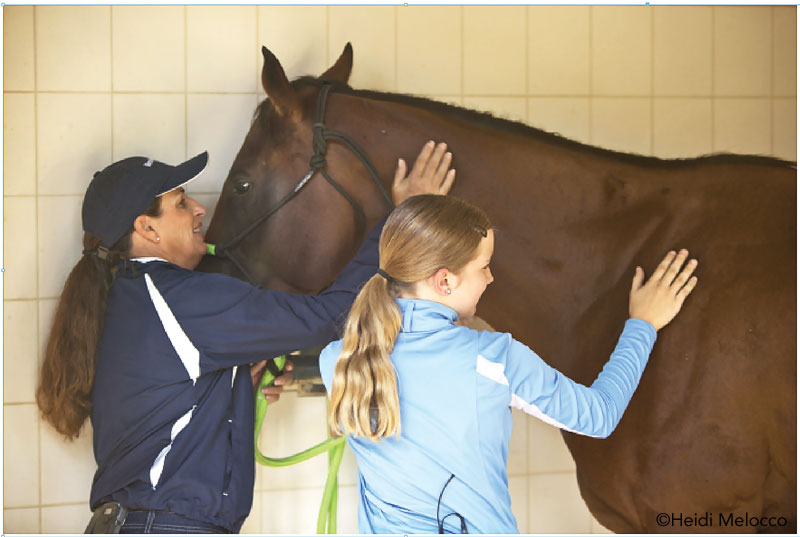Via: Horsechannel
Horses bite and kick at each other in the herd. That’s appropriate behavior for them when turned out together. But that’s not appropriate behavior when humans are present, and you have to teach your horse what isn’t acceptable in your presence. If your horse has rules and structure and you are willing to admonish as well as praise your horse, you’ll have a partner that’s wonderful to be around.
Horse Psychology
Because horses are herd animals, they seek out acceptance. In your herd of two, you need to be the leader and understand how your interactions with your horse mimic what is taught in the herd. Make it clear to him that you are a firm leader (not rough, but worthy of respect) and he’ll soon be requesting your acceptance and working hard for you.
If you try to start a new relationship by pampering and giving treats, that goes against everything he knows in the herd. He won’t seek out your acceptance if your acceptance comes for no reason. Once the horse knows that you are willing to dish out the pressure in a correction when it is deserved, you may never have to discipline him again. He’ll learn to be a little more careful around you. He’ll also want to gain your respect and praise.
Positive or Negative?
So how should you correct or praise your horse in order to have the best relationship? Consider positive and negative reinforcement. Negative reinforcement isn’t punishment; it just means removing pressure. Positive reinforcement means adding an incentive.
No matter which type of reinforcement you offer, you need the horse to associate your response with what he did. Make sure to give the correction or reward within three seconds of the behavior—and the closer to the behavior you can give the reinforcement within that three seconds, the better. Timing is everything when you’re training horses—horses live in the moment and they need the correction or reward to be immediate.
I recently worked with a young horse owner named Chloe and her newly off-the-track Thoroughbred. The mare was kicking out if anyonetouched her around the stifle or attempted to wash this sensitive area. I taught Chloe to hold her hand (or the water) on the area as long as the horse was picking up her foot and threatening to kick. As soon as the mare relaxed and accepted the pressure of the girl’s hand or the water, we took away the pressure and gave the horse a rest. This is negative reinforcement because you are taking away the pressure when the mare does the right thing. Horses feel pressure keenly and respond well to this method.
In positive reinforcement, you have to wait for the horse to have the correct response, then reward it. You may offer a verbal praise, petting and stroking or even giving a treat. A horse will work hard for praise even when a treat isn’t included. In working with Chloe and her mare, we made sure to praise the mare with soft voices and strokes on her neck when she tried hard and didn’t offer to kick or pick up her foot. When she did the right thing, she got a positive reinforcement immediately.
Time for Praise
It’s so important to praise your horse. But if you only dish out praise for your horse (whether it’s earned or not) and he never gets scolded for doing something bad, why would he keep working hard to earn your praise? If your praise comes too easily, there’s no reason to try to earn it. Just as he needs praise for doing something really well, he needs to be admonished when he does something wrong.
I always want to praise the horse for making an effort. I don’t expect my horses to try hard every minute on every ride, but if I ask something more challenging and the horse tries his best, I want to reach down and stroke his neck. The best reward you can give is to allow your horse to take a break and to leave him alone. If I’m working on rollbacks with my young horse, Eddie, and he’s done a great job and been responsive, I’ll give him a break and allow him to just stand there and take a breather with no further interaction from me.
Firm but Kind
Every horse is different in temperament and sensitivity. What is a harsh scolding to one horse may go unnoticed to another. If your horse is eager to please and is sensitive, the slightest correction will affect him. If your horse is insensitive and strong-willed, you may need a stronger correction. Plus, each situation is different—what the horse did, what prompted the behavior, and what motivated the horse to act that way.
Whatever pressure you use, it needs to be enough pressure to motivate change. Keep in mind that pressure can be mental pressure, a move in his direction, a verbal cue or actual physical pressure to touch the horse. If you correct your horse over and over for the same behavior, you’re not using enough pressure. What’s more, you’re teaching the horse that you aren’t worthy of respect. He can ignore you without consequence.
How much pressure should you use? That depends. I err on the side of using more at first to see what reaction I’ll get, in the hopes that I’ll never need to do it again. You lose more by under-correcting instead of over-correcting. If the horse misbehaves and you use one strong correction, you may never have to issue a second one. If I under-correct, I may have to correct again and again, and that’s a really bad start to a relationship.
--End--


